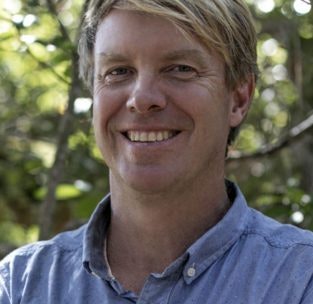The Cape Floral Kingdom, an area of 90,000 square km at the southern-most tip of South Africa, is one of the earth’s richest but most threatened centres of biodiversity. It is one of the world’s floral kingdoms, where at least 70% of the 9,000 plant species occur nowhere else on the planet.
Here, the ‘fynbos’ is the best-known vegetation type and home to many of the species we buy as cut flowers or grow in gardens: freesias, gladioli, ericas, proteas and leucodendrons, and includes 112 red-data species. The future of these plants is threatened by habitat degradation, exotic plant invasions, afforestation, untimely fires and hybrid cultivation.

Part of the Cape Floral Kingdom is the Walker Bay Fynbos Conservancy (WBFC), only very recently established (April 2000). It covers an area of 13,000 ha from the Walker Bay coastline to the inland mountains, and includes a number of rare and threatened species and habitats.
Botanist Sean Privett has been the ‘driving force’ behind the setting up of the WBFC, which he now heads. Since gaining his Master of Science in Botany in 1997, he has immersed himself in the world of plants and the environment in South Africa. His work has concentrated on conservation issues in the Cape Floral Kingdom, where he has worked with international and local NGOs on a range of different projects.
In 1997, he became Reserve Manager at the Grootbos Nature Reserve, which is now one of 16 properties making up the Walker Bay Fynbos Conservancy. One of the first tasks in setting it up has been the coordination and fostering of links between the different landowners in order to facilitate the conservation programmes.

At the WBFC, Sean Privett has put together a constitution and an interim conservation management plan for the area. The Conservancy includes approximately 10% of the species of the Cape Floral Kingdom, and a number of the rare and threatened species.
He has overseen important surveys of vegetation communities and alien plant species, incorporating them into alien plant eradication programmes and fire control strategies. Invasion by alien plant species and uncontrolled fires pose major threats to the conservancy and their careful management is crucial for the future conservation of the area. He is presently involved in developing a strategy for nature-based tourism as an incentive for private landowners to conserve their land. These projects have attracted both national and international attention.

The development of conservancies, a model of public-private partnerships between landowners and the nature conservation authorities, is one of the crucial tools that will be necessary to achieve the conservation targets for biodiversity in the Cape Floral Kingdom, says a colleague. Sean describes the Walker Bay Fynbos Conservancy as an excellent example of how a conservation arrangement with private landowners can work, enabling landowners to manage their biodiversity in a sustainable way.
2021 Continuation Funding
£70,000 over two years
Fine Flowers: Nurturing the Green Economy within South Africa’s Walker Bay Fynbos Conservancy
Succulents, spiky reeds, orchids, shrubs and flamboyant lilies: the Cape Floral Kingdom on South Africa’s southwestern tip is home to the highest concentration of plant species on the planet. Blanketing the mountainous, coastal landscape, fynbos vegetation encompasses over 9,000 species, 70% of which grow nowhere else on earth. These plants are crucial to the water cycle; where they have been replaced by thirsty invasive trees, rainwater released to Cape Town’s reservoirs has reduced by over 60%. As well as humans, fynbos support animals including the endemic orange-breasted sunbird, baboon, jackal, geometric tortoise and Critically Endangered Table Mountain ghost frog.
However, socio-economic realities paint a less pretty picture. COVID-19 has caused unemployment to rocket to 40% in communities bordering the Walker Bay Fynbos Conservancy, while conservation funding, generated by ecotourism, has collapsed. The resultant rise in illegal flower harvesting, logging, and poaching is compounded by ongoing waves of invasive plant species.
Sean Privett and the Grootbos Green Futures Foundation will address the root cause of threats to fynbos by creating green income opportunities for local people. They will welcome 20 new people – at least 16 of them women – to the conservation sector, support six eco-entrepreneurship grants, upskill 20 existing employees, and mentor 20 community members. By building on his successful track record of engaging landowners in conservation, Sean will also ensure conservationists can access private properties home to crucial areas of fynbos, across the biome.



